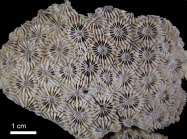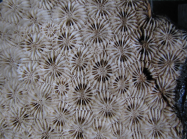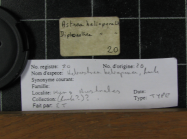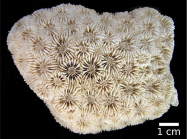
| Intro | | About | | Wiki | | Search traits | | Data explorer | | Literature | | Definitions | | Sources | | Webservices | | Statistics | | Feedback | | Editors | | Log in |
WoRMS taxon detailsDiploastrea heliopora (Lamarck, 1816)
207417 (urn:lsid:marinespecies.org:taxname:207417)
accepted
Species
Acanthastrea patula (Dana, 1846) · unaccepted > junior subjective synonym
Acanthastrea patula var. paucidentata Gregory, 1900 · unaccepted > junior subjective synonym
Astraea (Fissicella) heliopora Lamarck, 1816 · unaccepted > superseded combination
Astraea (Orbicella) glaucopis Dana, 1846 · unaccepted > junior subjective synonym
Astraea (Orbicella) glaucopsis Dana, 1846 · unaccepted > junior subjective synonym (misspelling)
Astraea (Orbicella) patula Dana, 1846 · unaccepted > junior subjective synonym
Astraea heliopora (Lamarck, 1816) · unaccepted > superseded combination (misspelling)
Astrea glaucopis (Dana, 1846) · unaccepted > junior subjective synonym
Astrea heliopora Lamarck, 1816 · unaccepted > superseded combination (basionym)
Astrea patula (Dana, 1846) · unaccepted > junior subjective synonym
Diploastraea heliopora (Lamarck, 1816) · unaccepted > misspelling - incorrect subsequent spelling
Diploastrea glaucopsis (Dana, 1846) · unaccepted > junior subjective synonym
Diploastrea heliopora var. borneensis Gerth, 1923 † · unaccepted > junior subjective synonym
Diploastrea heliopora var. fragilis Chevalier, 1975 · unaccepted > junior subjective synonym
Diploastrea patula (Dana, 1846) · unaccepted > junior subjective synonym
Heliastrea heliopora (Lamarck, 1816) · unaccepted > superseded combination
Montastraea curta var. heliopora (Lamarck, 1816) · unaccepted > superseded combination
Orbicella glaucopsis (Dana, 1846) · unaccepted > junior subjective synonym (misspelling)
Orbicella heliopora (Lamarck, 1816) · unaccepted > superseded combination
Orbicella minikoensis Gardiner, 1904 · unaccepted > junior subjective synonym (misspelling)
Orbicella minikoiensis Gardiner, 1904 · unaccepted > junior subjective synonym
Orbicella patula (Dana, 1846) · unaccepted > junior subjective synonym
marine,
recent + fossil
(of Astrea heliopora Lamarck, 1816) Lamarck, [J.-B. M.] de. (1816). <i>Histoire naturelle des animaux sans vertèbres</i>. Tome second, 566 pp. Paris, Verdière. , available online at http://www.biodiversitylibrary.org/item/47698 [details]
Holotype (of Astrea heliopora Lamarck, 1816) MNHN...
Holotype (of Astrea heliopora Lamarck, 1816) MNHN scle20, verbatimGeounit Habite les mers Aust... [details] Unreviewed
Type locality "Indian Ocean" (Veron, 1986). [details]
Description Colonies are distinctive, massive, and often exceed 1 metre across. Corallites are round and closely packed, plocoid, and...
Description Colonies are distinctive, massive, and often exceed 1 metre across. Corallites are round and closely packed, plocoid, and formed by extratentacular budding. They are 8 to 10 mm diameter. The most characteristic feature of Diploastrea heliopora is its corallite wall structure. Walls are not solid but are delineated or formed by the thickened outer ends of the septa, which are not attached to each other laterally. This feature can even be detected beneath the tissue of the live corals. Shallow and mid-depths are preferred, almost always in sheltered water. The largest colonies are usually seen in silty environments, so it is commonly found on protected fringing reefs and back reef slopes, often beside sandy patches. Although it may grow to great size and colonies are by no means rare, vast expanses dominated by this species, as may occur in Indian Ocean atoll lagoons, have not been seen in areas such as the Red Sea. The coral is always a uniform brown. (Sheppard, 1998 <308>) Colonies are dome-shaped with a very even surface and may be up to 2 m high and 7 m in diameter. The skeleton is very dense. Corallites are plocoid. Columellae are large. Septa are equal and are thick at the wall and thin where they join the columellae. Polyps are extended only at night. Colour: usually uniform cream or grey, sometimes greenish. Abundance: occurs in both exposed and protected reef habitats but is usually uncommon except on some back reef margins. (Veron, 1986 <57>) May form large, massive domed colonies up to 5 m across or more. Corallites closely packed and domed, 10-20 mm across, with clearly visible columellae and distinct septal walls. Colour: uniform pale green to grey or cream. Habitat: diverse. (Richmond, 1997) [details]
Hoeksema, B. W.; Cairns, S. (2025). World List of Scleractinia. Diploastrea heliopora (Lamarck, 1816). Accessed through: World Register of Marine Species at: https://www.marinespecies.org/aphia.php?p=taxdetails&id=207417 on 2025-07-16
Date action by
Nomenclatureoriginal description
(of Astrea heliopora Lamarck, 1816) Lamarck, [J.-B. M.] de. (1816). <i>Histoire naturelle des animaux sans vertèbres</i>. Tome second, 566 pp. Paris, Verdière. , available online at http://www.biodiversitylibrary.org/item/47698 [details] original description (of Orbicella minikoiensis Gardiner, 1904) Gardiner JS. (1904). Madreporaria Parts I. and II: I. Introduction with notes on variation, II. Astraeidae. <em>Fauna and geography of the Maldives and Laccadives Archipelagoes, Cambridge.</em> 2: 736-790, pls. 59-64. [details] original description (of Astraea (Orbicella) patula Dana, 1846) Dana, J.D. (1846-1849). Zoophytes. United States Exploring Expedition during the years 1838-1842. <em>Lea and Blanchard, Philadelphia.</em> 7: 1-740, 61 pls. (1846: 1-120, 709-720; 1848: 121-708, 721-740; 1849: atlas pls. 1-61)., available online at https://www.biodiversitylibrary.org/page/18989497, http://www.sil.si.edu/digitalcollections/usexex/navigation/ScientificText/USExEx19_08select.cfm [details] original description (of Diploastrea heliopora var. borneensis Gerth, 1923 †) Gerth H. (1923). Die Anthozoënfauna des Jungtertiars von Borneo. <em>Sammlungen des Geologischen Reichs-Museums in Leiden, Serie 1. Beiträge zur Geologie Ost-Asiens und Australiens.</em> 10 (1): 37-136, pls. 1-9. [details] original description (of Acanthastrea patula var. paucidentata Gregory, 1900) Gregory JW. (1900). The fossil corals of Christmas Christmas Island. <em>In: Andrews CW (ed.) A monograph of Christmas Island (Indian Ocean).</em> 206-225, pl. 19. [details] original description (of Diploastrea heliopora var. fragilis Chevalier, 1975) Chevalier JP. (1975). Les Scléractiniaires de la Mélanésie Française (Nouvelle-Caledonie, Iles Chesterfield, Iles Loyauté, Nouvelles Hébrides). II. Expedition Française sur les Récifs Coralliens Nouv.-Calédonie. 7: 1-407, pls. 1-42. Paris. [details] original description (of Astraea (Orbicella) glaucopis Dana, 1846) Dana, J.D. (1846-1849). Zoophytes. United States Exploring Expedition during the years 1838-1842. <em>Lea and Blanchard, Philadelphia.</em> 7: 1-740, 61 pls. (1846: 1-120, 709-720; 1848: 121-708, 721-740; 1849: atlas pls. 1-61)., available online at https://www.biodiversitylibrary.org/page/18989497, http://www.sil.si.edu/digitalcollections/usexex/navigation/ScientificText/USExEx19_08select.cfm [details] basis of record Veron JEN. (1986). Corals of Australia and the Indo-Pacific. <em>Angus & Robertson Publishers.</em> [details] new combination reference Matthai G. (1914). A revision of the recent colonial Astraeidae possessing distinct corallites. <em>Transactions of the Linnean Society of London, 2nd Series Zoology.</em> 17(1): 1-140, pls. 1-38. [details] Othercontext source (Hexacorallia)
Fautin, Daphne G. (2013). Hexacorallians of the World. (look up in IMIS) [details]
additional source Veron JEN, Pichon M, Wijsman-Best M. (1977). Scleractinia of Eastern Australia – Part II. Families Faviidae, Trachyphylliidae. <em>Australian Institute of Marine Science Monograph series.</em> 3: 1-233. [details] additional source Dunn, D.F., 1970. Some observations on marine life at Pulau Aur, Johore. Malay. Nat. J. 23 : 158-167. page(s): 162 [details] additional source Hoffmeister, J.E. (1925). Some corals from America Samoa and the Fiji Islands. <em>Papers from the Department of Marine Biology of the Carnegie Institution of Washington.</em> 22: 1-90, pls. 1-23. page(s): 11, 12, 47 [details] additional source Vaughan TW. (1918). Some shallow-water corals from Murray Island (Australia), Cocos-Keeling Island, and Fanning Island. <em>Papers from the Department of Marine Biology of the Carnegie Institution of Washington.</em> 9 (213): 49-234, pls. 20-93. [details] additional source Cairns, S.D., B.W. Hoeksema & J. van der Land. (1999). Appendix: List of extant stony corals. <em>Atoll Research Bulletin.</em> 459: 13-46. page(s): 28 [details] additional source Randall RH. (2003). An annotated checklist of hydrozoan and scleractinian corals collected from Guam and other Mariana Islands. <em>Micronesica.</em> 35-36: 121-137. page(s): 133 [details] additional source Cairns, S.D., B.W. Hoeksema & J. van der Land. (2007). as a contribution to UNESCO-IOC Register of Marine Organisms. (look up in IMIS) [details] additional source Liu, J.Y. [Ruiyu] (ed.). (2008). Checklist of marine biota of China seas. <em>China Science Press.</em> 1267 pp. (look up in IMIS) [details] Available for editors additional source Benzoni, F., Stefani, F., Stolarski, J., Pichon, M., Mitta, G., Galli, P. 2007. Debating phylogenetic relationships of the scleractinian Psammocora: molecular and morphological evidences. Contributions to Zoology 76: 35-54., available online at https://doi.org/10.1163/18759866-07601004 page(s): 39 [details] Available for editors additional source Nemenzo, F. (1955). Systematic studies on Philippine shallow water scleractinians: I. Suborder Fungiida. <em>Natural and Applied Science Bulletin, University of the Philippines.</em> 15: 3-84. page(s): 6, 82-83, Plate VI, fig. 6 [details] additional source Veron JEN. (2000). Corals of the World. Vol. 1–3. <em>Australian Institute of Marine Science and CRR, Queensland, Australia.</em> [details] additional source Scheer G, Pillai CSG. (1974). Report on Scleractinia from the Nicobar Islands. <em>Zoologica, Stuttgart.</em> 42(122): 1-75. page(s): 9, 53, 74 [details] additional source Umbgrove JHF. (1939). Madreporaria from the Bay of Batavia. <em>Zoologische Mededelingen, Leiden.</em> 22: 1-64. page(s): 18, 42 [details] additional source Yabe H, Sugiyama T, Eguchi M. (1936). Recent reef-building corals from Japan and the South Sea Islands under the Japanese mandate. I. <em>The Science reports of the Tôhoku Imperial University, Sendai, 2nd Series (Geologie).</em> Special Volume 1: 1-66, pls. 1-59. page(s): 4, 54-55, Pl. XI [details] additional source Pillai CSG, Scheer G (1976) Report on the stony corals from the Maldive Archipelago. Results of the Xarifa Expedition 1957/58. Zoologica, Stuttgart 43 (126): 1-83, pls. 1-32. [details] additional source Crossland C (1952) Madreporaria, Hydrocorallinae, Heliopora and Tubipora. Scientific Report Great Barrier Reef Expedition 1928-29 VI(3): 85-257. page(s): 92, 166 [details] additional source Wijsman-Best M (1980) Indo-Pacific coral species belonging to the subfamily Montastreinae Vaughan and Wells, 1943 (Scleractinia-Coelenterata) part II: The genera Cyphastrea, Leptastrea, Echinopora and Diploastrea. Zoologische Mededelingen, Leiden 55: 235-263. [details] additional source Pichon, M.; Benzoni, F. (2007). Taxonomic re-appraisal of zooxanthellate Scleractinian Corals in the Maldive Archipelago. <em>Zootaxa.</em> 1441: 21–33. page(s): 32 [details] additional source Huang D, Benzoni F, Fukami H, Knowlton N, Smith ND, Budd AF (2014) Taxonomic classification of the reef coral families Merulinidae, Montastraeidae, and Diploastraeidae (Cnidaria: Anthozoa: Scleractinia). Zoological Journal of the Linnean Society 171: 277–355., available online at https://doi.org/10.1111/zoj.12140 [details] additional source Matthai G (1924) Report on the madreporarian corals in the collection of the Indian Museum, Calcutta. Memoirs of the Indian Museum 8: 1-59. [details] additional source Veron JEN, Marsh LM. (1988). Hermatypic corals of Western Australia : records and annotated species list. <em>Records Western Australian Museum Supplement.</em> 29: 1-136., available online at https://doi.org/10.5962/bhl.title.60555 page(s): 28, 112 [details] additional source Pillai CSG. (1972). Stony corals of the seas around India. <em>Proceedings of the First International Symposium on Corals and Coral Reefs, 1969. Marine Biological Association of India Symposium.</em> 5: 191-216. page(s): 195, 207 [details] additional source Randall RH, Myers RF. (1983). The corals. Guide to the Coastal Resources of Guam: Vol. 2. <em>University of Guam Press, Guam, pp. 128.</em> [details] additional source Veron, J. E. N. (2000). Corals of the World, Volume III: Families Mussidae, Faviidae, Trachyphylliidae, Poritidae. Australian Institute of Marine Science. Townsville., volume 3, pp. 490. page(s): 230-231 [details] additional source Ryland, J. S. (1981). Reefs of southwest Viti Levu and their tourism potential. Proceedings of the Fourth International Coral Reef Symposium, 1, 293-298 page(s): 296-297 [details] additional source Maragos, J. E. (2004). Baker Island coral data [Table unnumbered]. UNPUBLISHED, Unpublished page(s): 1 [details] additional source Wells JW. (1954). Recent corals of the Marshall Islands: Bikini and nearby atolls, part 2, oceanography (biologic). <em>U.S. Geological Survey Professional Paper.</em> 260(I): 385-486. page(s): 394, 464 [details] additional source Pillai CSG. (1983). Structure and generic diversity of recent Scleractinia of India. <em>Journal of the Marine Biological Association of India.</em> 25, 1-2, 78-90. page(s): 87 [details] additional source Sheppard, C. R. C. (1985). Fringing reefs in the southern region, Jeddah to Jizan. Fauna of Saudi Arabia, 7, 37-58 page(s): 45 [details] additional source Cornish, A. S.; DiDonato, E. M. (2004). Resurvey of a reef flat in American Samoa after 85 years reveals devastation to a soft coral (Alcyonacea) community. Marine Pollution Bulletin, 48, 768-777 page(s): 773 [details] additional source Kühlmann, D. H. H. (2006). Die Steinkorallensammlung im Naturhistorischen Museum in Rudolstadt (Thüringen) nebst ökologischen Bemerkungen. Rudolstädter Naturhistorische Schriften, 13, 37-113 page(s): 63, 90, 112 [details]  Present Present  Present in aphia/obis/gbif/idigbio Present in aphia/obis/gbif/idigbio  Inaccurate Inaccurate  Introduced: alien Introduced: alien  Containing type locality Containing type locality
Holotype (of Astrea heliopora Lamarck, 1816) MNHN scle20, verbatimGeounit Habite les mers Aust... [details]
Nontype HLD X2: 136-34, geounit Indian Exclusive Economic Zone [details]
Nontype HLD X2: 151-3(a,b), geounit Indian Exclusive Economic Zone [details]
Nontype HLD X2: 154-14, geounit Indian Exclusive Economic Zone [details]
Nontype IGPS 50730, geounit Micronesian Exclusive Economic Zone [details]
Nontype IGPS 53079, geounit Micronesian Exclusive Economic Zone [details]
Nontype IGPS 56674, geounit Palau Exclusive Economic Zone [details]
Nontype NMSR 8971, geounit Tanzanian Exclusive Economic Zone [details]
Nontype RMNH, geounit Indonesian Exclusive Economic Zone [details]
Nontype WAM 420-78, geounit Australian Exclusive Economic Zone [details]
Nontype WAM 454-78, geounit Australian Exclusive Economic Zone [details]
Nontype WAM 455-78, geounit Australian Exclusive Economic Zone [details]
Nontype WAM 456-78, geounit Australian Exclusive Economic Zone [details]
Nontype WAM 917-85, geounit Australian Exclusive Economic Zone [details]
Syntype (of Orbicella minikoiensis Gardiner, 1904) NHMUK 1927.5.4.152, verbatimGeounit Minicoy, Lakshadweep... [details]
From editor or global species database
Biology zooxanthellate [details]Unreviewed
Description Colonies are distinctive, massive, and often exceed 1 metre across. Corallites are round and closely packed, plocoid, and formed by extratentacular budding. They are 8 to 10 mm diameter. The most characteristic feature of Diploastrea heliopora is its corallite wall structure. Walls are not solid but are delineated or formed by the thickened outer ends of the septa, which are not attached to each other laterally. This feature can even be detected beneath the tissue of the live corals. Shallow and mid-depths are preferred, almost always in sheltered water. The largest colonies are usually seen in silty environments, so it is commonly found on protected fringing reefs and back reef slopes, often beside sandy patches. Although it may grow to great size and colonies are by no means rare, vast expanses dominated by this species, as may occur in Indian Ocean atoll lagoons, have not been seen in areas such as the Red Sea. The coral is always a uniform brown. (Sheppard, 1998 <308>)Colonies are dome-shaped with a very even surface and may be up to 2 m high and 7 m in diameter. The skeleton is very dense. Corallites are plocoid. Columellae are large. Septa are equal and are thick at the wall and thin where they join the columellae. Polyps are extended only at night. Colour: usually uniform cream or grey, sometimes greenish. Abundance: occurs in both exposed and protected reef habitats but is usually uncommon except on some back reef margins. (Veron, 1986 <57>) May form large, massive domed colonies up to 5 m across or more. Corallites closely packed and domed, 10-20 mm across, with clearly visible columellae and distinct septal walls. Colour: uniform pale green to grey or cream. Habitat: diverse. (Richmond, 1997) [details] Type locality "Indian Ocean" (Veron, 1986). [details]
To Barcode of Life (7 barcodes)
To Biodiversity Heritage Library (25 publications) To Biodiversity Heritage Library (7 publications) (from synonym Orbicella minikoiensis Gardiner, 1904) To Biological Information System for Marine Life (BISMaL) To European Nucleotide Archive, ENA (Diploastrea heliopora) To GenBank (73 nucleotides; 45 proteins) (from synonym Astrea heliopora Lamarck, 1816) To GenBank (73 nucleotides; 45 proteins) To IUCN Red List (Least Concern) To USNM Invertebrate Zoology Cnidaria Collection (35 records) To ITIS |




